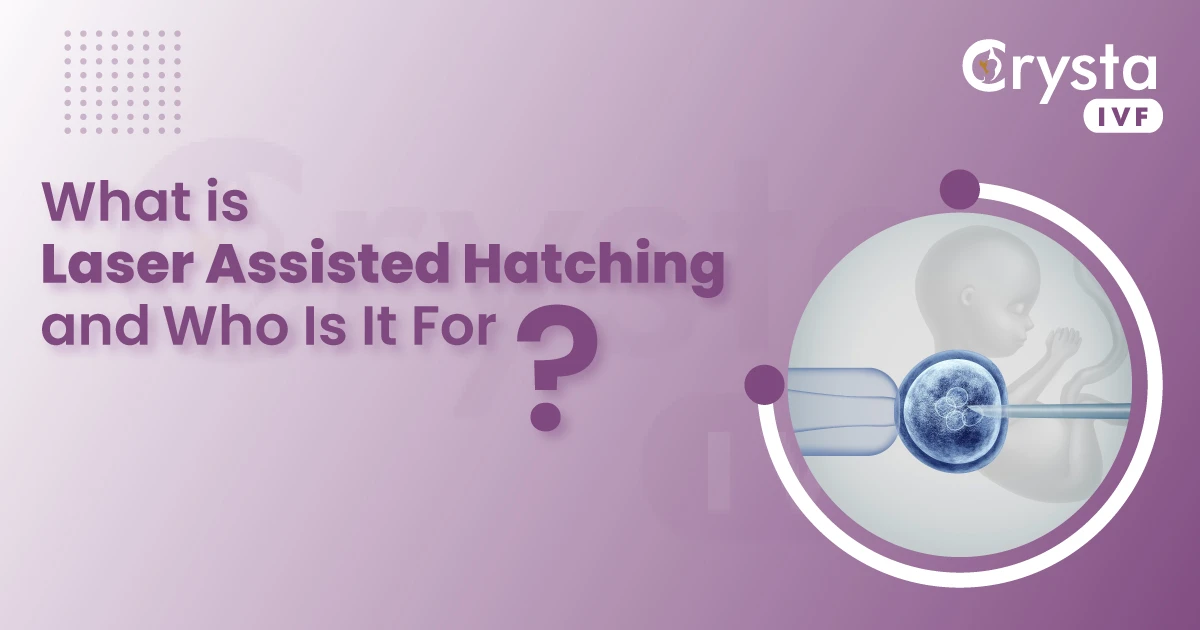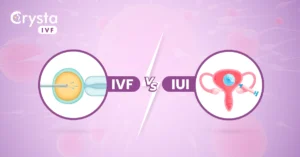Let’s make it simple to understand. The line to a successful pregnancy is not straight, but filled with ups and downs. Just because you chose the IVF procedure, it doesn’t mean confirmed pregnancy. Laser Assisted Hatching is for the ones who, even after getting the IVF procedure done, fail to become pregnant.
Sometimes, for certain reasons, the fertilised egg cannot latch on the uterus’s endometrial wall.
Learn more about the endometrial wall at – https://crystaivf.com/blogs/what-is-the-era-test/
But why does this happen? Let’s dive into the details.
During the IVF procedure, the fertilised egg is observed for 2–5 days to grow and develop into an embryo. Once the embryo is ready, it’s implanted in a woman’s uterus. During the development process, the embryo is coated with a layer called zona pellucida. Zona pellucida is a protective barrier surrounding the embryo that assists in fertilisation, supports early embryo development, and triggers the initiation of implantation during the early phases of embryonic development.
During the implantation process, the barrier breaks and allows the embryo to fuse with the uterine wall, thus, beginning the process of a successful pregnancy. But in some cases, the embryo’s outer layer, zona pellucida, hardens and refuses to break apart, making it difficult for the embryo to hatch and latch to the wall.
This is where Laser Assisted Hatching comes into play. A microscopic laser makes a tiny tear in the barrier, letting the embryo hatch and fuse with the wall. This marks the beginning of pregnancy in women.
Why do we need LAH?
First of all, just because you’re undergoing IVF, it does not mean you require Laser Assisted Hatching (LAH). Doctors believe that although LAH significantly increases the chances of pregnancy through IVF, it’s only necessary for certain types of couples. Before going for LAH, doctors analyse all your medical records and infertility history which assists them in planning the most suitable treatment for you.
If certain conditions are met, the doctors only go for LAH. The following conditions are:
- Two or more failed IVF cycles.
- If you have increased FSH level
- The quality of your embryo is poor.
- When your age is 38 or older
- Unexplained infertility

Why Do You Need Laser Assisted Hatching in IVF?
It has been found that as women get older, they produce eggs with thicker zona pellucida or outer shells. The same issue has been seen in women with higher follicle-stimulating hormone (FSH). In such cases, using LAH has been beneficial as it helps break the barrier for easy latching of the embryo with the uterine wall.
Also, women who choose to freeze their eggs face the same problem. Their eggs develop a hard outer layer of zona pellucida. LAH treatment proves to be helpful for cases like this as it makes it easy for the embryo to merge with the uterus and begin the process of pregnancy.
Hatching is a natural process and happens easily during IVF procedures. But sometimes, it is unable to due to the thick outer barrier. But even this is rare. It is important to discuss all this with our doctors at Crysta IVF. It’s your right to ask relevant questions about IVF and LAH. Learn about the pros and cons of undergoing LAH treatment.
LAH Procedure
The process of Laser Assisted Hatching starts on the 3rd day of fertilisation. The embryo is still in the lab and is kept under observation. If it’s found that the zona pellucida (the outer barrier) is too thick and would create problems in the hatching process of the embryo, a specialised microscopic laser is used to create a breach. The laser technology allows for a more controlled approach, is safe, and most effective technique. Crysta IVF has skilled technicians and specialised instruments to perform this procedure. This entire procedure takes only a few seconds to complete.
In this process, the laser shots are used to soften the barrier and create an opening for the embryo to hatch. The best part about this technique is that the laser does not reach the embryo, maintaining the optimum condition of fertilisation.
Advantages of LAH:
The laser’s intensity is pre-programmed, ensuring the embryo’s safety and survival. LAH is a more accurate method as compared to other hatching techniques. It does not involve manual embryo handling, ensuring minimal chances of damage.
Laser Assisted Hatching Risks:
The risk of Laser Assisted Hatching is quite similar to ICSI or IVF. LAH is done when the embryo cannot naturally break open from the barrier. Being an assisted procedure, it involves a few risks.
- One LAH risk is the potential damage to the embryo. There is a reason why only the most expert technicians do this procedure. Any mistake in the pre-programming of the laser can damage the embryo by breaching the zona pellucida.
- Also, there is another possibility that even though LAH was successful, due to the coating of the embryo being too thick, the embryo simply cannot hatch. Any more tear on the zona pellucida can damage the embryo.
- LAH can lead to multiple pregnancies. There is already a possibility of multiple pregnancies with IVF, laser assisted hatching can further increase the risk. But, there’s no need to worry as the chances of that happening are less than 1%.
There is an ongoing myth surrounding LAH that it can cause congenital anomalies in babies. However, this is not true at all, as there have been multiple studies on the matter and all of them revealed that the procedure does not cause any such problems.
Why Crysta IVF?
Hatching of the embryo is a mandatory procedure in pregnancy. Laser Assisted Hatching significantly increases the chances of successful implantation and pregnancy. However, due to the associated risks with the procedure, only the most experienced technicians must conduct this. Crysta IVF olds its mission to fulfil the dream of all the couples who want to experience parenthood. Thus, we take extra precautions with all the procedures involved with IVF. Our team of expert doctors and embryologists carefully analyze the patients and create a personalised treatment plan. We understand the amount of hopes and dreams you put on us and we ensure that it never breaks. Our state-of-the-art technology and process help streamline the entire procedure, giving you all the right information so you can make informed decisions about your fertility.

For more information regarding IVF and Laser Assisted Procedure, visit our website https://crystaivf.com/ or call us at 893 893 5353.
 Verified by Crysta IVF Fertility Experts
Verified by Crysta IVF Fertility Experts
Related Blogs:
Tips for Successful IVF Treatment & Frozen Embryo Transfer
What are the positive signs to look after an embryo transfer?
Body Changes after Embryo Transfer
Foods to Eat and Avoid After Embryo Transfer: A Comprehensive Guide




